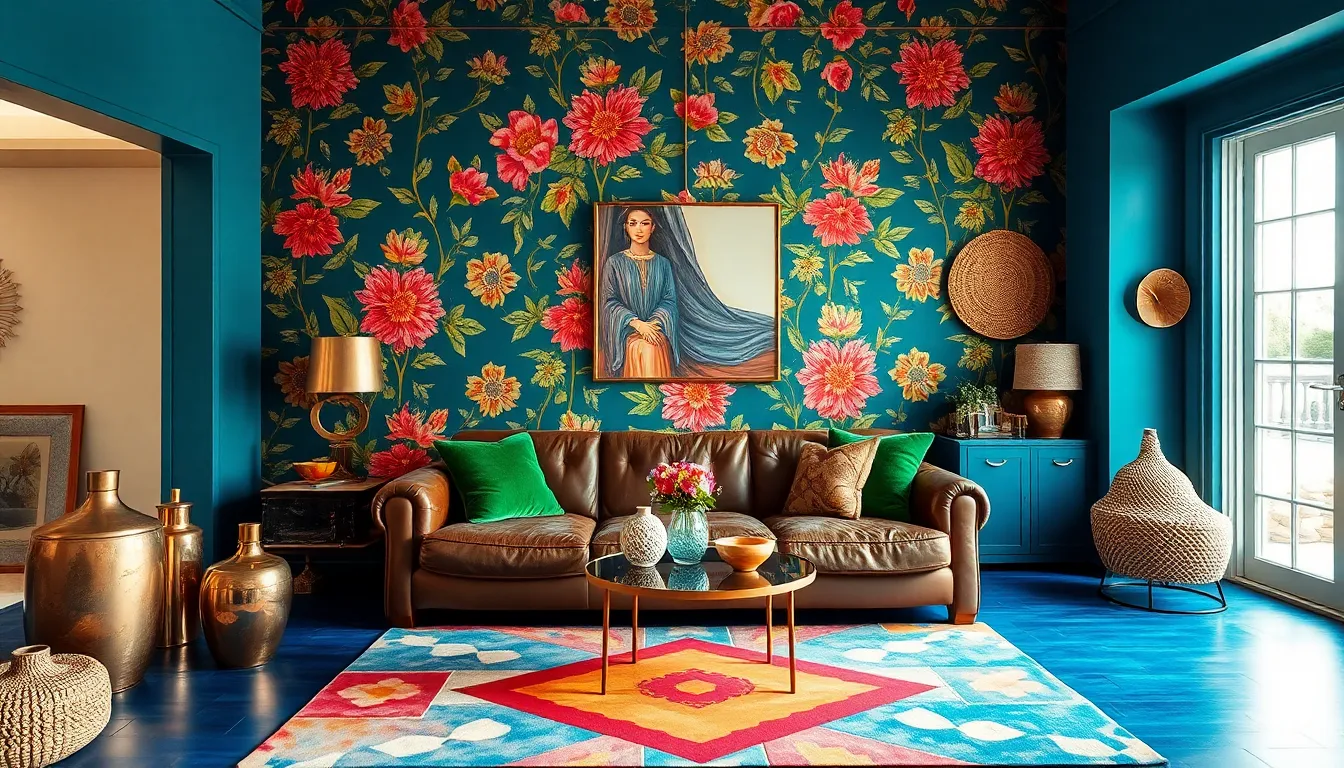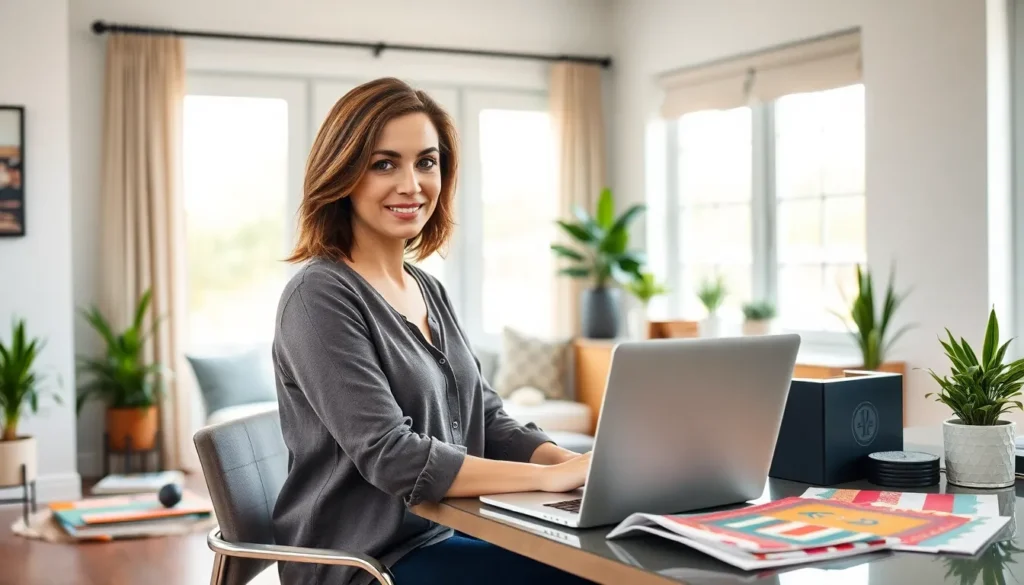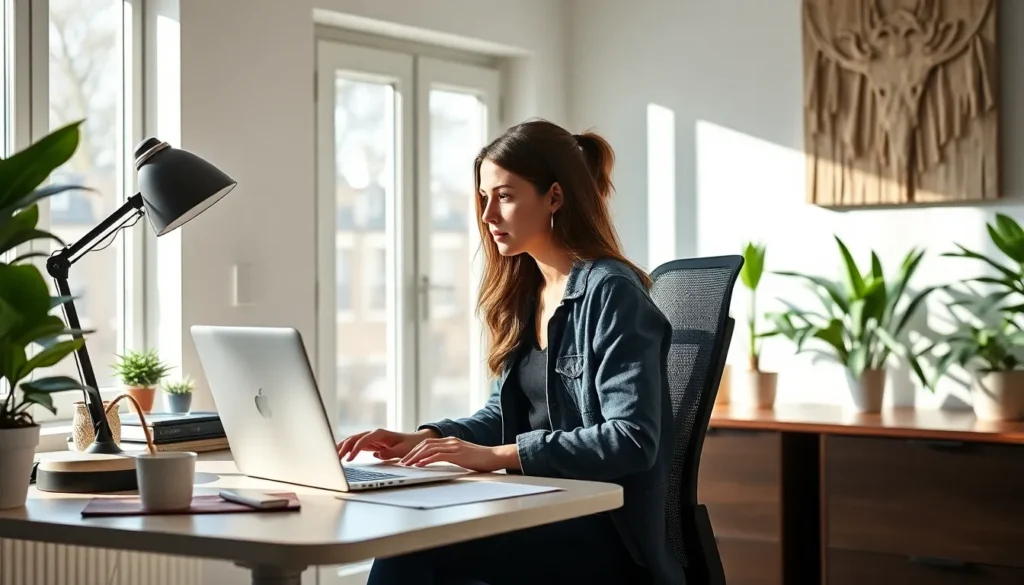Maximalist interior design isn’t just a trend; it’s a glorious celebration of excess that invites personality into every nook and cranny of a space. Gone are the days of minimalism where less was more. Instead, it’s time to embrace the notion that more is, quite frankly, more! Picture vibrant colors, eclectic patterns, and a delightful chaos that tells a story—your story.
Table of Contents
ToggleOverview of Maximalist Interior Design
Maximalist interior design embodies vibrancy and personal expression, celebrating abundance in home decor. Bold colors dominate this style, creating lively environments that reflect the homeowner’s personality. Eclectic patterns mix together seamlessly, producing a sense of delightful chaos. Each element, from furniture to accessories, tells a story and showcases individual experiences.
Emphasis on layering defines maximalism, where various textures and colors coexist harmoniously. Decorative items aren’t limited to a few; they include collections, art pieces, and souvenirs from travels. Curated chaos allows for creativity to flourish, inviting personal touches into every corner.
Furniture choices within this style assert bold statements. Unique shapes and striking designs stand out, promoting comfort and function. Some prefer oversized pieces that command attention, while others opt for an array of smaller items that contribute to a cohesive look. Lighting fixtures also play an important role, with ornate chandeliers or quirky lamps enhancing the overall aesthetic.
Maximalism also includes the use of greenery and natural elements. Plants add freshness and life to the space, further enriching the atmosphere. Combining different styles, like vintage and modern, creates a layered and dynamic environment.
Overall, maximalist interior design defies traditional norms, encouraging freedom and creativity. It allows individuals to curate spaces that embody their unique stories, making each home a distinct reflection of its inhabitant. This approach contrasts sharply with minimalism, providing an outlet for those drawn to more expressive and personalized decor.
Key Characteristics of Maximalist Interior Design

Maximalist interior design showcases the exuberance of individuality in home decor through distinct features. Bold colors and patterns combine to create vibrant atmospheres that captivate the eye and energize spaces.
Bold Colors and Patterns
Vivid hues define maximalism, encouraging a fearless approach to color choices. Rich tones such as deep blues, fiery reds, and lush greens interact, making statements throughout rooms. Patterns also play a crucial role, with floral prints, geometric shapes, and intricate designs layered seamlessly. Accessories such as cushions and curtains often feature these patterns, creating energetic contrasts that draw attention. Walls may display artistic murals or wallpaper boasting dynamic designs. With these elements, every surface tells a story, celebrating individuality.
Eclectic Mix of Textures
Texture adds depth and warmth to maximalist interiors. Varieties such as smooth glass, rough wood, and plush fabrics coexist harmoniously in spaces. Rugs, throws, and cushions introduce comfort, inviting relaxation while layering visual interest. Artwork and decorative objects often feature unique textures, from metallic finishes to woven elements. Surfaces like velvet, leather, and natural fibers enhance tactile experiences, encouraging exploration and engagement. By intertwining these elements, maximalism fosters a rich sensory environment that invites personalization.
Historical Context of Maximalist Interior Design
Maximalist interior design draws inspiration from diverse historical periods, reflecting cultural richness and artistic movements.
Influences from Different Eras
Victorian design laid a foundation for maximalism, showcasing ornate details and heavy embellishment. Art Deco, with its bold geometric shapes and luxurious finishes, influenced modern interpretations. The 1960s and 1970s introduced vibrant colors and experimental patterns, significantly shaping contemporary maximalist aesthetics. Postmodernism embraced eclectic styles, further promoting individuality in design. Each era contributes layers of meaning and visual interest, making maximalism a celebration of historical depth and innovation.
Cultural Inspirations
Cultural narratives infuse maximalist design with vibrant elements. African, Asian, and Latin American textiles inspire unique patterns and colors, enhancing visual storytelling. Global artifacts like handwoven baskets or ceramic pieces serve as focal points, connecting spaces to heritage. Inspirations from various cultures create a tapestry of influences that enrich the design and foster a sense of adventure. Through these cultural references, maximalism becomes not just a style but a narrative woven from diverse traditions and experiences.
Benefits of Maximalist Interior Design
Maximalist interior design offers numerous advantages, enhancing both aesthetics and functionality in living spaces.
Personal Expression and Creativity
Maximalist spaces allow individuals to showcase their unique tastes. This approach invites diverse elements, such as personal art collections and travel mementos. Homeowners often feel more connected to their environment through vibrant colors and eclectic patterns. Comfort emerges from the combination of various textures that create inviting atmospheres. Layers of soft fabrics and bold prints tell stories of personal experiences. Each piece contributes to a broader narrative, reflecting individuality and creativity. Embracing maximalism fosters a sense of freedom, enabling people to craft environments that truly represent their personalities.
Creating Inviting Spaces
Creating inviting spaces becomes easier with maximalist design principles. Bold colors set a lively mood, instantly making rooms feel more welcoming. Thoughtful arrangement of furniture promotes both comfort and conversation. Layered textures invite touch, enhancing the overall sensory experience. Natural elements, like plants and wood, integrate freshness, balancing the vibrancy with warmth. Unique lighting fixtures highlight focal points, drawing attention to decorative features. By blending styles and cultural influences, maximalism transforms ordinary spaces into extraordinary experiences. Each room conveys movement and energy, making them perfect for relaxation and social gatherings.
Challenges of Maximalist Interior Design
Maximalist interior design presents unique challenges that can impact the overall effectiveness of the style. Understanding these obstacles aids in creating a balanced and cohesive environment.
Potential for Overwhelm
Maximalism often embraces vibrant patterns and bold colors. Such an abundance can sometimes lead to a visually overwhelming space. Homeowners may struggle with combining different elements harmoniously. Avoiding clutter in a maximalist environment becomes essential to maintain appeal. Effective curation of accessories and furniture fosters a sense of cohesion even amidst diversity. Designers recommend establishing a focal point to attract the eye and provide balance. A well-placed piece of artwork or furniture can create an anchor amidst the exuberance.
Balancing Aesthetics and Functionality
Maximalist design prioritizes visual impact while demanding functional spaces. Striking the right balance can prove challenging for homeowners. Every decorative item should not only enhance aesthetics but also serve a practical purpose. Ensuring comfort alongside visual appeal promotes usability in daily life. Thoughtful arrangement of furniture enhances flow and accessibility in a room. Designers emphasize mixing styles while maintaining a cohesive narrative. Planning storage solutions for excess items mitigates clutter and enhances functionality. Ultimately, establishing a fine line between beauty and usability remains crucial in maximalist interior design.
Maximalist interior design stands as a bold celebration of individuality and creativity. By embracing vibrant colors and eclectic patterns homeowners can create spaces that resonate with their personal stories. This style encourages a layering of textures and styles that not only enhances aesthetics but also fosters a sense of warmth and comfort.
While it may present challenges in achieving harmony, the careful curation of elements can lead to stunning results. With thoughtful planning and a focus on functionality, maximalism transforms ordinary spaces into extraordinary environments. Ultimately, it invites everyone to express themselves freely and make their homes a true reflection of who they are.





